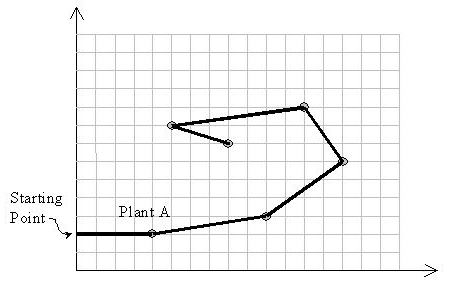POJ 1696 Space Ant(凸包变形)
Description
- It can not turn right due to its special body structure.
- It leaves a red path while walking.
- It hates to pass over a previously red colored path, and never does that.
The pictures transmitted by the Discovery space ship depicts that plants in the Y1999 grow in special points on the planet. Analysis of several thousands of the pictures have resulted in discovering a magic coordinate system governing the grow points of the plants. In this coordinate system with x and y axes, no two plants share the same x or y.
An M11 needs to eat exactly one plant in each day to stay alive. When it eats one plant, it remains there for the rest of the day with no move. Next day, it looks for another plant to go there and eat it. If it can not reach any other plant it dies by the end of the day. Notice that it can reach a plant in any distance.
The problem is to find a path for an M11 to let it live longest.
Input is a set of (x, y) coordinates of plants. Suppose A with the coordinates (xA, yA) is the plant with the least y-coordinate. M11 starts from point (0,yA) heading towards plant A. Notice that the solution path should not cross itself and all of the turns should be counter-clockwise. Also note that the solution may visit more than two plants located on a same straight line. 
Input
Output
#include <cstdio>
#include <cstring>
#include <iostream>
#include <algorithm>
#include <cmath>
using namespace std; const double EPS = 1e-; inline int sgn(double x) {
return (x > EPS) - (x < -EPS);
} struct Point {
double x, y;
Point() {}
Point(double x, double y): x(x), y(y) {}
void read() {
scanf("%lf%lf", &x, &y);
}
bool operator < (const Point &rhs) const {
if(y != rhs.y) return y < rhs.y;
return x < rhs.x;
}
Point operator + (const Point &rhs) const {
return Point(x + rhs.x, y + rhs.y);
}
Point operator - (const Point &rhs) const {
return Point(x - rhs.x, y - rhs.y);
}
Point operator * (const int &b) const {
return Point(x * b, y * b);
}
Point operator / (const int &b) const {
return Point(x / b, y / b);
}
double length() const {
return sqrt(x * x + y * y);
}
Point unit() const {
return *this / length();
}
};
typedef Point Vector; double dist(const Point &a, const Point &b) {
return (a - b).length();
} double across(const Point &a, const Point &b) {
return a.x * b.y - a.y * b.x;
}
//turn left
bool cross(const Point &sp, const Point &ed, const Point &op) {
return sgn(across(sp - op, ed - op)) > ;
} /*******************************************************************************************/ const int MAXN = ; Point p[MAXN];
bool del[MAXN];
int n, T; void solve() {
memset(del, , sizeof(del));
int last = ;
for(int i = ; i < n; ++i)
if(p[i] < p[last]) last = i;
for(int i = ; i < n; ++i) {
printf(" %d", last + );
del[last] = true;
int t = ;
for(t = ; t < n; ++t) if(!del[t]) break;
for(int j = ; j < n; ++j) {
if(del[j] || j == t) continue;
if(cross(p[j], p[t], p[last])) t = j;
}
last = t;
}
} int main() {
scanf("%d", &T);
while(T--) {
scanf("%d", &n);
int t;
for(int i = ; i < n; ++i)
scanf("%d", &t), p[i].read();
printf("%d", n);
solve();
puts("");
}
}
POJ 1696 Space Ant(凸包变形)的更多相关文章
- POJ 1696 - Space Ant 凸包的变形
Technorati Tags: POJ,计算几何,凸包 初学计算几何,引入polygon后的第一个挑战--凸包 此题可用凸包算法做,只要把压入凸包的点从原集合中排除即可,最终形成图形为螺旋线. 关于 ...
- poj 1696 Space Ant (极角排序)
链接:http://poj.org/problem?id=1696 Space Ant Time Limit: 1000MS Memory Limit: 10000K Total Submissi ...
- 2018.07.04 POJ 1696 Space Ant(凸包卷包裹)
Space Ant Time Limit: 1000MS Memory Limit: 10000K Description The most exciting space discovery occu ...
- poj 1696:Space Ant(计算几何,凸包变种,极角排序)
Space Ant Time Limit: 1000MS Memory Limit: 10000K Total Submissions: 2876 Accepted: 1839 Descrip ...
- POJ 1696 Space Ant 卷包裹法
Space Ant Time Limit: 1000MS Memory Limit: 10000K Total Submissions: 3316 Accepted: 2118 Descrip ...
- POJ 1696 Space Ant(极角排序)
Space Ant Time Limit: 1000MS Memory Limit: 10000K Total Submissions: 2489 Accepted: 1567 Descrip ...
- poj 1696 Space Ant(模拟+叉积)
Space Ant Time Limit: 1000MS Memory Limit: 10000K Total Submissions: 3840 Accepted: 2397 Descrip ...
- POJ 1696 Space Ant(点积的应用)
Space Ant 大意:有一仅仅蚂蚁,每次都仅仅向当前方向的左边走,问蚂蚁走遍全部的点的顺序输出.開始的点是纵坐标最小的那个点,開始的方向是開始点的x轴正方向. 思路:从開始点開始,每次找剩下的点中 ...
- 简单几何(凸包) POJ 1696 Space Ant
题目传送门 题意:一个蚂蚁一直往左边走,问最多能走多少步,且输出路径 分析:就是凸包的变形题,凸包性质,所有点都能走.从左下角开始走,不停排序.有点纠结,自己的凸包不能AC.待理解透凸包再来写.. 好 ...
随机推荐
- Python提高篇
Python提高篇 1.模块 1)模块定义 模块就是py文件,可以是你自己写的,也可以是python当中自带的工具,当你在某个py文件下想要引用其他模块的功能,就需要你把你把该py文件导入. 2)导入 ...
- 分布式缓存 Redis(二)
代码实例 namespace RedisTest { class Program { static void Main(string[] args) { Student stu = RedisOper ...
- Cannot send session cache limiter - headers already sent问题
在php.ini中将“always_populate_raw_post_data ”设置为“-1”,并重启
- TCC : Tiny C Compiler (2018-2-6)
饭墙下载,有缘上传: https://files.cnblogs.com/files/bhfdz/tcc-0.9.27-win32-bin.zip https://files.cnblogs.com/ ...
- 十分钟搭建和使用ELK日志分析系统
前言 为满足研发可视化查看测试环境日志的目的,准备采用EK+filebeat实现日志可视化(ElasticSearch+Kibana+Filebeat).题目为“十分钟搭建和使用ELK日志分析系统”听 ...
- IIC总线协议和时序
IIC标准速率为100Kbit/s,快速模式400Kbit/s,支持多机通信,支持多主控模块,但是同一时刻只允许有一个主控.由数据线SDA和时钟SCL构成串行总线:每个电路模块都有唯一地址.I2C设备 ...
- Java设计模式(23)——行为模式之访问者模式(Visitor)
一.概述 概念 作用于某个对象群中各个对象的操作.它可以使你在不改变这些对象本身的情况下,定义作用于这些对象的新操作. 引入 试想这样一个场景,在一个Collection中放入了一大堆的各种对象的引用 ...
- The Git Parable:Git传说(转)
The Git Parable:Git传说 -------- 毛球子好为人师 原文地址:http://tom.preston-werner.com/2009/05/19/the-git-parable ...
- 结合《需求征集系统》谈MVC框架
结合<需求征集系统>分析MVC框架. 六个质量属性: 可用性:在系统压力过大时,会提示系统繁忙. 可修改性:使用配置文件,修改配置文件即可.对于一些公共的方法,进行封装,修改时,只需修改封 ...
- [AGC011F] Train Service Planning [线段树优化dp+思维]
思路 模意义 这题真tm有意思 我上下楼梯了半天做出来的qwq 首先,考虑到每K分钟有一辆车,那么可以把所有的操作都放到模$K$意义下进行 这时,我们只需要考虑两边的两辆车就好了. 定义一些称呼: 上 ...
